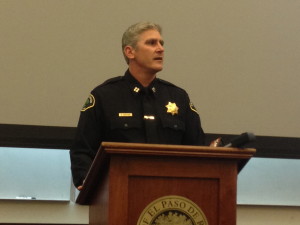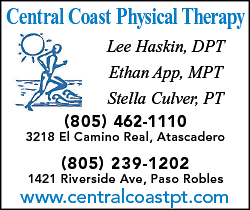Council moves to prohibit aggressive panhandling
Police chief advocates ordinance to prohibit aggressive solicitation

Police Chief Robert Burton
Paso Robles Police Chief Robert Burton warns that “an increase in aggressive solicitation throughout the city has become extremely disturbing and disruptive to residents and businesses, and has contributed not only to the loss of access to and enjoyment of public places, but also to an enhanced sense of fear, intimidation and disorder.”
The warning is in a report to Paso Robles City Council members ahead of their Dec. 3 meeting. “The city does not currently have the police power to address aggressive solicitation through our current codes,” his report says.
The council approved a reading of the ordinance, which is expected to take effect after its Jan. 7, 2014 meeting.
“The presence of individuals who solicit money from persons at or near banks or automated teller machines is especially threatening and dangerous,” he writes. “In addition, actively soliciting vehicles within the roadway and near the entrance and exit of parking lots and structures creates traffic hazards, including impeding the safe, orderly flow of traffic.”
These behaviors cannot be mitigated through the enforcement of existing regulations, including those contained in the vehicle code, Burton says. He recommends a new ordinance that would provide the city with specific enforcement authority to control unwanted behaviors while providing for constitutionally protected activities. This would be accomplished by continuing to allow active solicitation on most sidewalks, he says. It “ensures persons have an adequate opportunity and avenue to engage in constitutionally protected activities.”
The proposed ordinance would prohibit aggressive solicitation
- Approaching or speaking to a person, or following a person before, during or after soliciting, asking or begging, if that conduct is intended or is likely to cause a reasonable person to fear bodily harm to oneself or to another, damage to or loss of property, or otherwise be intimidated into giving money or other thing of value;
- Intentionally touching or causing physical contact with another person or an occupied vehicle without that person’s consent in the course of soliciting, asking or begging;
- Intentionally blocking or interfering with the safe or free passage of a pedestrian or vehicle by any means, including unreasonably causing a pedestrian or vehicle operator to take evasive action to avoid physical contact;
- Using violent or threatening gestures toward a person solicited either before, during, or after soliciting, asking or begging;
- Persisting in closely following or approaching a person, after the person solicited has been solicited and informed the solicitor by words or conduct that such person does not want to be solicited or does not want to give money or any other thing of value to the solicitor; or
- Using profane, offensive or abusive language which is inherently likely to provoke an immediate violent reaction, either before, during, or after solicitation.
Solicitation would be prohibited in specific areas
- Within twenty-five feet of any ATM or similar cash machine, bank, or savings and loan; or
- By approaching an operator or occupant of a motor vehicle while such vehicle is located on any public street, any median of a public street, any parking lot or structure, or within six feet of any vehicular entrance or exit of any parking lot or structure, provided, however, that this subsection shall not apply to services rendered in connection with emergency services or repairs requested by the operator or passenger of such vehicle. Parked Vehicle Exemption: This shall not apply to vehicles lawfully parked within a public street. Sidewalk Exemption: This shall not apply to any sidewalk or walkway unless located within ten feet of the vehicular entrance or exit of any parking lot or structure.
- Within any public transportation vehicle. This shall not apply to public transportation vehicles operated by the federal government or the state or any of its subdivisions.
- In any non-public places except with the property owner’s or lawful occupant’s written consent which shall be produced upon request.
Comments
Scott Brennan is the publisher of this newspaper and founder of Access Publishing. Follow him on Twitter, LinkedIn, or follow his blog.





















